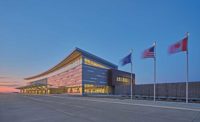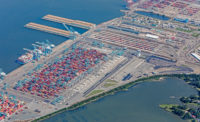Turkmenbashi International Seaport
Turkmenbashi, Turkmenistan
Best Project & Project of the Year Finalist
Owner State Service of Maritime and River Transport
Lead Design Firm, Civil, Structural and MEP Engineer 2ER Müsavirlik Proje Kontrollük ve Tic. A.S.
General Contractor GAP INSAAT A.S.
Architect MB Mimarlık
Builders, suppliers and subcontractors from 20 countries made this seaport expansion in Turkmenbashi, Turkmenistan, a very international construction project. The team, led by EPC contractor GAP INSAAT A.S., built $1.5 billion in new facilities for the State Service of Maritime and River Transport of Turkmenistan. Global suppliers contributed elevators from Japan, a shiplift system from Norway, cranes from Germany and scanning equipment from the U.S., among other things. Work included a ferry and passenger terminal, a container terminal and many related facilities.
A challenge for lead designer 2ER Müsavirlik Proje Kontrollük ve Tic. A.S. was the high seismic activity along the Ashkabad Fault Zone between the South Caspian and Eurasian blocks—a region rated at 9+ on a Russian seismic scale running from one to 12. To determine an accurate design-basis earthquake, the team conducted a geological survey that showed a near-fault line passing through the north side of the project area, leading to the adoption of the Turkish Seismic Code for Marine Structures as well as ASCE 61-14, among others, for design of the seaport facilities.
The port’s location on the Caspian Sea gives it the huge value of access via the Volga-Don Canal to trade routes throughout the Black Sea and beyond. Still, GAP INSAAT reports there were logistical challenges with delivery of materials and equipment because this route is often closed between November and April or even May due to icing. In addition, the route can be closed in August because of sturgeon runs.
The project team was sensitive to this type of environmental issue because its goal was to meet the key provisions of both local and international standards for eco-friendly ports. This involves proper waste and hazardous waste handling, energy conservation, air and water quality protection and noise reduction.
Efforts included protecting local wildlife habitats, a particular challenge here because Turkmenbashi Bay is the site of a UNESCO World Heritage-protected nature reserve. Large birds such as flamingos and swans used an existing shallow waterway to congregate in the winter and the coastal vegetation provided breeding habitats for birds such as the black-winged stilt and Kentish plover. To protect and even enhance these conditions, the project team built a 1.7-million-sq-meter artificial island in the bay—using 12 million cu m of dredged material—as a habitat for migratory birds. Almost 70 different species have been observed there, some arriving while construction was still underway.
The port was built partly on reclaimed land created using soil improvement methods new to the region. After sandfilling, prefabricated vertical drains were used for soil consolidation followed by rapid impact soil compaction with hydraulic hammers to reduce liquefaction and seismic-induced settlement and to collapse voids. Work included deep soil mixing—mechanically mixing weak soils with cementitious binder slurry.
Project leaders emphasized safety and safety training. With nearly 43 million hours of work logged by employees, GAP conducted 11,800 toolbox talks and 1,900 inspections. Every employee had to refresh safety training every three months, with special training implemented for those working at heights or doing excavation or waste management.
GAP reports that work was completed on budget and one month ahead of schedule.










Post a comment to this article
Report Abusive Comment